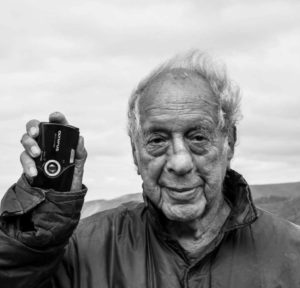Robert Frank

It might seem strange that, given the current political climate, Americans can agree on anything. And yet, it seems, that they do, which is, that The Americans by Robert Frank is insightful (not inciteful, although it was at first), highly influential, and of “pivotal” importance to documentary photography. This is unexpected, given that The Americans is not exactly a flattering portrait.
The Americans, published in the United States in 1959, wasn’t received with the public applause it now enjoys. In the 1950s, America saw itself as an ideological champion: having put down the Nazis in World War II, they were now taking on the communists, and their economy was booming. Frank’s pictures, however, did not match this rosy outlook. The Americans was received with disapproval and charges of anti-Americanism. Franks’s response? “I was tired of Romanticism,” he said. “I wanted to present what I saw, pure and simple.”

Jewish and Swiss-born, Frank was protected from the holocaust by his country’s neutrality. He emigrated to the United States in 1947 as an artistic refugee, fleeing “small-minded values.” As a photographer, he worked with Edward Steichen, Walker Evans, Diane Arbus, and Saul Leiter. In 1955, Steichen included seven of Frank’s photographs in the Family of Man exhibit. In the same year, Evans supported his application for a Guggenheim grant “to photograph freely throughout the United States.” The grant was awarded, and for the next two years, Frank traveled throughout the United States with his 35 mm. Leica camera, taking 28,000 photographs. Eighty-three of these pictures made it into the book.
Much has been written about The Americans:
- “moody, cool intensity…. elegantly framed… as blurry and off-center as an amateur snapshot… alternately empathetic and obstreperous” (Arthur Lubow for the New York Times).
- “…an indictment of American society, stripping away the picture-perfect vision of the country and its veneer of breezy optimism … a personal offhand style that sought to capture the look and feel of spontaneity in an authentic moment” (Philip Gefter for the New York Times).
- “…the outsider genius whose photographs laid bare America’s soul” (Sean O’Hagan for the Guardian).
I moved to America from England when I was twenty-three years old, pregnant with a honeymoon baby, and a recent graduate from university. My first impression of America came from Detroit’s huge freeways and potholes. A few months later, my husband and I flew west, then drove back to Michigan in a borrowed car. By Chicago, I was in awe of the size of the country, that we could drive further still. My first year was spent translating what I heard into what I knew. What exactly did Americans mean when they asked, “Hello, how are you?” Did they really want to know? My eventual conclusion was that they didn’t. Ironically, I find Americans to be genuine, friendly, and kind; I don’t understand why it can be such a lonely place. Like Frank, I am an outsider looking in.
Of Frank’s photographs in The Americans, I’ve chosen two pictures: “Fourth of July—Jay, New York,” and “Charleston, South Carolina.”
Americans are crazy proud of their flag and display it everywhere: buildings, parades, parties, and more. This was striking to me, coming from England. No one really waves a flag in England, except for the Queen. In “Fourth of July—Jay, New York,” the flag is faded, transparent, and torn — not the picture-perfect patriotism that Americans of the 1950s liked to portray.

The picture below, of an Black nanny and a white baby, addresses racial paradoxes in American life.

“Robert Frank kicked documentary photography into the present with a loud clang,” argues Lubow. He “chafed like a bridled horse at conforming to a preordained narrative” — what Frank called “those goddamned stories with a beginning and an end.” His documentary style was new, personal, and poetic. It is Frank’s idiosyncratic vision that I most value in The Americans.
Later in life, Frank mostly gave up on photography. Maybe it was the death of his daughter in 1974 or the death of his son in 1994; the death of a child surely impacts any parent. He died in 2019, at age 94 years.
